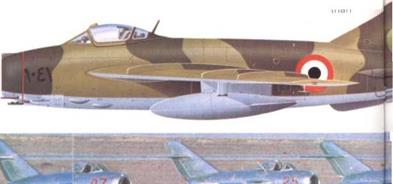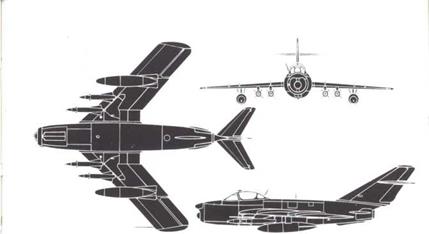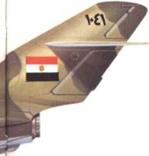Mikoyan/Gurevich MiG-17
MiG-17, -17P, -17F (Lim-5P and -5M,
S-104, F-4), -17PF and -17PFU (NATO name "Fresco")
Origin: The design bureau of Mikoyan and Gurevich, Soviet Union: licence-production as described in the text.
Type: Single-seat fighter; (PF, PFU) limited all-weather interceptor. Engine: (-17. -17P) one 5.952lb (2700kg) thrust Klimov VK-1 singleshaft centrifugal turbojet: (later versions) one 4,732/7,452lb (3380kg) VK-1F with afterburner.
Dimensions: Span 31ft (9-45m); length (all) 36ft 3in (11’05m); height 11ft (3’35m).
Weights: Empty (all) about 9.040lb (4100kg); loaded (F. clean) 11,7731b (5340kg): maximum (all) 14,7701b (6700kg)
Performance: Maximum speed (F, clean at best height of 9,840ft) 711mph (1145km/h); initial climb 12,795ft (3900m)/min; service ceiling 54,460ft (16,600m); range (high, two drop tanks) 913 miles (1470km). Armament: (-17) as MiG-15, one 37mm and two 23mm NS-23; (all later versions) three 23mm Nudelmann-Rikter NR-23 cannon, one under right side of nose and two under left; four wing hardpoints for tanks, total of 1,1021b (500kg) of bombs, packs of eight 55mm air-to-air rockets or various air-to-ground missiles.
History: First flight (prototype) January 1950; service delivery, 1952; service delivery (F-4) January 1956; final delivery (Soviet Union) probably 1959.
Users: Afghanistan. Albania, Algeria, Angola, Bulgaria, China, Cuba, Czechoslovakia, Egypt, E Germany, Guinea. Hungary, Indonesia (in storage), Iraq, Kampuchea, N Korea, Mali, Morocco (in storage), Nigeria. Poland, Romania, Somalia. S Yemen. Soviet Union, Sri Lanka, Sudan. Syria, Tanzania, Uganda, Vietnam, Yemen Arab.
 Development: Only gradually did Western observers recognise the MiG-17 as not merely a slightly modified MiG-15 but a completely different aircraft. Even then it was generally believed it had been hastily designed to rectify deficiencies shown in the MiG-1 5’s performance in Korea, but in fact the design began in about January 1949, long before the Korean war. This was because from the first the MiG-1 5 had shown bad behaviour at high speeds, and though the earlier fighter was eventually made completely safe (partly by arranging for the air brakes to open automatically at Mach 0-92) it was still a difficult gun platform due to its tendency to snake and pitch. The MiG-17 – which was probably the last fighter in which Gurevich played a direct personal role — had a new wing with thickness reduced from 11 per cent to about 9 pet cent, a different section and planform and no fewer
Development: Only gradually did Western observers recognise the MiG-17 as not merely a slightly modified MiG-15 but a completely different aircraft. Even then it was generally believed it had been hastily designed to rectify deficiencies shown in the MiG-1 5’s performance in Korea, but in fact the design began in about January 1949, long before the Korean war. This was because from the first the MiG-1 5 had shown bad behaviour at high speeds, and though the earlier fighter was eventually made completely safe (partly by arranging for the air brakes to open automatically at Mach 0-92) it was still a difficult gun platform due to its tendency to snake and pitch. The MiG-17 – which was probably the last fighter in which Gurevich played a direct personal role — had a new wing with thickness reduced from 11 per cent to about 9 pet cent, a different section and planform and no fewer

Above: Three-view of typical MiG-17F (NATO name, "Fresco C").
three fences. Without taper and with inboard sweep of 47° this made a big difference to high-Mach behaviour, and in fact there are reasons to believe the MiG-17 can be dived to make a sonic bang. With a new tail on a longer rear fuselage the transformation was completed by considerable revision of systems and equipment, though at first the VK-1 engine was unchanged. In 1958 the first limited all-weather version, the -17P, went into modest production with longer nose housing the same Izumrud (”Scan Odd") Al radar and ranging avionics as was also in production for the MiG-19. With the introduction of an afterburning engine the airbrakes were moved aft of the wing, away from the hot back end, but this was not a good position and they were returned (in enlarged rectangular form) to the tail in the most important sub-type the -17F. This was made in Poland as the Lim-5P (the -5M being a rough-field close-support version with larger tyres and drag chute), in Czechoslovakia as the S-104 and in China as the F-4. The PF was the afterburning all-weather version, and the final model was the PFU with guns removed and wing pylons for four beam-riding "Alkali" air-to-air missiles. Total production for at least 22 air forces must have considerably exceeded 5.000, exports from China alone exceeding 1,000. Many 17F remained in use in the mid-1970s.


Left: This MiG-17F is one of about 50 which in 1980 were still serving with the Syrian Air Force. Used in the low-level attack role, it is now obsolescent but may continue as a weapon trainer.










